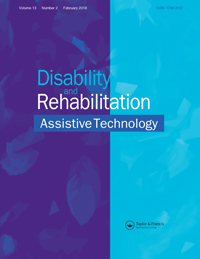| Authors | Simon Judge, Nicky Randall, Juliet Goldbart, Yvonne Lynch, Liz Moulam, Stuart Meredith & Janice Murray |
|---|---|
| Journal | Disability and Rehabilitation: Assistive Technology, April 2019 |
| DOI | https://doi.org/10.1080/17483107.2019.1604828 |

| Authors | Simon Judge, Nicky Randall, Juliet Goldbart, Yvonne Lynch, Liz Moulam, Stuart Meredith & Janice Murray |
|---|---|
| Journal | Disability and Rehabilitation: Assistive Technology, April 2019 |
| DOI | https://doi.org/10.1080/17483107.2019.1604828 |

Background: Symbol communication aids are used by children with little or no intelligible speech as an Augmentative and Alternative Communication strategy. Graphic symbols are used to help support understanding of language and used in symbol communication aids to support expressive communication. The decision making related to the selection of a symbol communication aid for a child is poorly understood and little is known about what language and communication attributes are considered in this selection.
Aim: To identify from the literature the language or communication attributes of graphic symbol communication aids that currently influence AAC practice.
Method and Procedure: A search strategy was developed and searches were performed on a range of electronic databases for papers published since 1970. Quality appraisal was carried out using the CCAT tool and papers rated as weak were not included in the review.
Results: Eleven studies were included in the review reporting data from 66 participants. Weaknesses were identified in most studies that would limit the validity of the results for application to practice. Included studies investigated aspects of vocabulary organization and design, the process of vocabulary selection, and the choice of the symbol system and encoding method. Two studies also evaluated innovative communication aid attributes.
Conclusions: Information from studies reported in the research literature provides a sparse source of information about symbol communication aids from which clinicians, children or family members may make informed decisions.